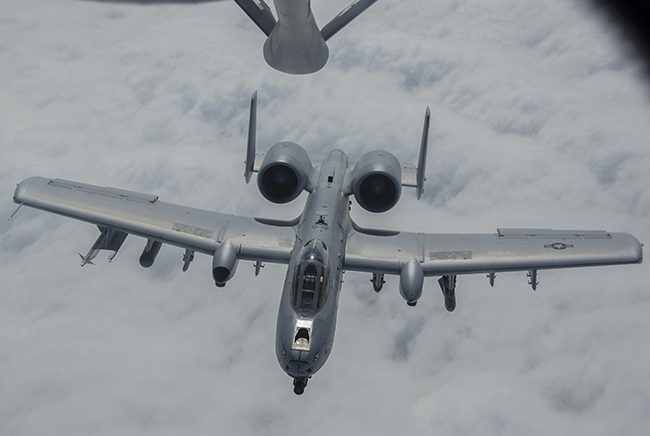
An A-10 Thunderbolt II from the 122nd Fighter Wing, Fort Wayne, Ind., approaches the boom of a KC-135R Stratotanker from the 434th Air Refueling Wing, Peru, Ind., to be refueled during the Employer Support of the Guard and Reserve Boss Lift on April 26, 2019. Air National Guard photo by SSgt. Lonnie Wiram)
Comparative testing of the Air Force’s F-35 and A-10 to measure their performance in combat search-and-rescue, close air support, and airborne forward air control missions wrapped up earlier this spring, and should spur conversations about how best to partner fourth- and fifth-generation aircraft in combat, the Pentagon’s top weapons tester said Thursday.
The 2016 and 2017 National Defense Authorization Acts ban the Air Force from retiring or divesting A-10s until the F-35 is vetted to see how well it can perform the Warthog’s missions.
About two-thirds of the testing was done last year, and the aircraft returned in March for a final look, according to Robert Behler, the Defense Department’s director of operational test and evaluation. While the flights were intensive and instructive, he noted the tests were not a fly-off.
Testers pitted the planes against anti-aircraft weapons, man-portable air defense systems, and moving targets like radar-guided surface-to-air missiles, Behler told the House Armed Services tactical air and land forces subcommittee. Each aircraft flew during the day and night, and were vetted in urban environments. One segment involved a downed crew member and required collaboration with other platforms like the HH-60.
As anticipated, the F-35 proved to be a valuable close air support asset, according to prepared testimony submitted by Air Force Acquisition Executive Will Roper.
“The F-35, as we expected, has a big advantage in a high-threat scenario where the stealth and sensor fusion really help,” Behler added. “In a lesser threat environment, we were able to put more weapons on the wings of the F-35, so we were able to get much better loads on the aircraft.”
Comparatively, the A-10 performed well with more fuel and more weapons in a low-threat environment.
“One thing that can’t be overlooked is that there’s 40 years of experience close to the ground with the A-10,” Behler said. “Training really matters. We had, in the second part of the testing in March, we had former A-10 pilots that are now part of the F-35 force.”
He told Rep. Ruben Gallego (D-Ariz.) the biggest effect the report may have is to spur the Air Force to develop new tactics for flying fourth- and fifth-generation aircraft together in combat.
“When we flew the fifth-gen and the fourth-gen [planes], there was a very good synergy of the two platforms,” Behler said. “The F-35 works as a great quarterback. It’s like a mini [Airborne Warning and Control System] out there, data fusion to be able to coordinate with the fourth-gen [aircraft] really provides a good performance.”
The full report is due to Congress at the end of the year.